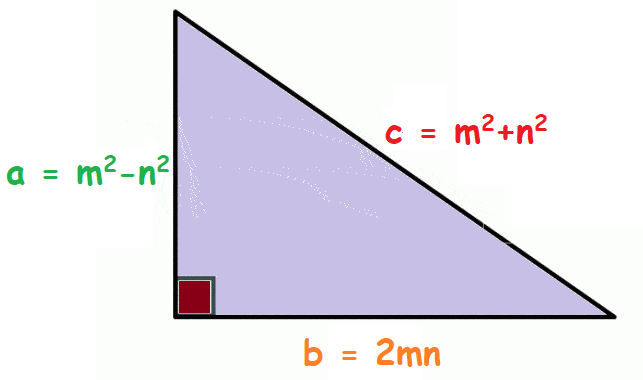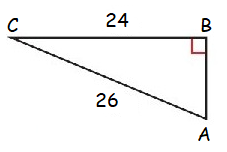FINDING WHETHER GIVEN LENGTHS ARE PYTHAGOREAN TRIPLES
Subscribe to our ▶️ YouTube channel 🔴 for the latest videos, updates, and tips.
What are Pythagorean triples ?
Pythagorean triples are the three positive integers that completely satisfy the Pythagorean theorem.
That is,
a2 + b2 = c2
where,
c is the hypotenuse (or) longest side of the right triangle.
a and b are the other two sides of lengths of the right triangle.
These three sides of the right triangle form the Pythagorean triples.
The Pythagorean triples are represented as {a, b, c}.
How to generate Pythagorean triples ?
If given any values of a Pythagorean triple, then the three integers can be generated by using the formula,

a = m2 - n2, b = 2mn, and c = m2 + n2.
(where m and n are positive integers, such that m > n)
Example 1 :
Find whether the lengths {5, 12, 13} is a Pythagorean triples.
Solution :
Let a = 5, b = 12, and c = 13 be the lengths.
By Pythagorean theorem,
a2 + b2 = c2
(5)2 + (12)2 = (13)2
25 + 144 = 169
169 = 169
So, {5, 12, 13} is a Pythagorean triples.
Example 2 :
Find whether the lengths {6, 1, 7} is a Pythagorean triples.
Solution :
Let a = 6, b = 1, and c = 7 be the lengths.
By Pythagorean theorem,
a2 + b2 = c2
(6)2 + (1)2 = (7)2
36 + 1 = 49
37 ≠ 49
So, {6, 1, 7} is not a Pythagorean triples.
Example 3 :
What is the Pythagorean triples using the values, m = 7 and n = 6 ?
Solution :
Given, values m = 7 and n = 6.
We are using the m and n values, to find the {a, b, c} of Pythagorean triples.
Formula for generating Pythagorean triples,
Since (m > n),
a = m2 - n2, b = 2mn, and c = m2 + n2
|
Finding a a = m2 - n2 a = (7)2 - (6)2 = 49 - 36 a = 13 |
Finding b b = 2mn b = 2(7)(6) b = 84 |
Finding c c = m2 + n2 c = (7)2 + (6)2 = 49 + 36 c = 85 |
Now, a = 13, b = 84, and c = 85
So, {13, 84, 85} is the Pythagorean triples.
Example 4 :
What is the Pythagorean triples using the values, m = 2 and n = 1 ?
Solution :
Given, values m = 2 and n = 1.
We are using the m and n values, to find the {a, b, c} of Pythagorean triples.
Formula for generating Pythagorean triples,
Since (m > n),
a = m2 - n2, b = 2mn, and c = m2 + n2
|
Finding a a = m2 - n2 a = (2)2 - (1)2 = 4 - 1 a = 3 |
Finding b b = 2mn b = 2(2)(1) b = 4 |
Finding c c = m2 + n2 c = (2)2 + (1)2 = 4 + 1 c = 5 |
Now, a = 3, b = 4, and c = 5
So, {3, 4, 5} is the Pythagorean triples.
Example 5 :
Find the missing side length, and if the side lengths form a Pythagorean triple. Explain.

Solution :
Given, Hypotenuse side AC = 26, Length1 BC = 24 and Length2 AB = ?
Using Pythagorean theorem :
AB2 + BC2 = AC2
AB2 + (24)2 = (26)2
AB2 + 576 = 676
AB2 = 100
AB = 10
Length2 AB = 10
So, the lengths are 10, 24, and 26.
Since the square of the hypotenuse side is equal to the sum of the square of the other two sides, it is a Pythagorean triple.
Example 6 :
{p, 144, 145} is a Pythagorean triple, What is the value of p ?
Solution :
Let a = p, b = 144, and c = 145 be the lengths.
By Pythagorean theorem,
a2 + b2 = c2
p2 + (144)2 = (145)2
p2 + 20736 = 21025
p2 = 21025 - 20736
p2 = 289
p = 17
Now, {17, 144, 145} is a Pythagorean triple.
So, the value of p is 17.
Example 7 :
Joey tried a new route to reach his school today. He walked 6 blocks to the north, and then 8 blocks to the west. Find how far is his school from his home.
Solution :
The distance from the school to home is the length of the hypotenuse.
Let c be the missing distance from the school to home and a = 6, b = 8
By Pythagorean theorem,
a2 + b2 = c2
62 + 82 = c2
36 + 64 = c2
100 = c2
c = 10
So, the distance from school to home is 10 blocks.
Example 8 :
Ms. Green tells you that a right triangle has a hypotenuse of 13 and a leg of 5. She asks you to find the other leg of the triangle. What is your answer?
Solution :
Let x be the other leg.
x2 + 52 = 132
x2 + 25 = 169
x2 = 169 - 25
x2 = 144
x = √144
x = 12
Example 9 :
Two joggers run 8 miles north and then 5 miles west. What is the shortest distance, to the nearest tenth of a mile, they must travel to return to their starting point?
Solution :
Let x be the required distance.
x2 + 52 = 82
x2 + 25 = 64
x2 = 64 - 25
x2 = 39
x = √39
x = 6.24 units
Example 10 :
Shown is a right angle triangle. Calculate:
(a) the perimeter of the triangle.
(b) the area of the triangle

Solution :
Let x be the third side of the triangle.
x2 + 72 = 252
x2 + 49 = 625
x2 = 625 - 49
x2 = 576
x = √576
x = 24 units.
a) Perimeter of the triangle = 24 + 7 + 25
= 56 units
b) Area = (1/2) x base x height
= (1/2) x 24 x 7
= 12 x 7
= 84 square units.
Subscribe to our ▶️ YouTube channel 🔴 for the latest videos, updates, and tips.
Kindly mail your feedback to v4formath@gmail.com
We always appreciate your feedback.
©All rights reserved. onlinemath4all.com
Recent Articles
-
10 Hard SAT Math Questions (Part - 38)
Dec 08, 25 12:12 AM
10 Hard SAT Math Questions (Part - 38) -
SAT Math Practice
Dec 05, 25 04:04 AM
SAT Math Practice - Different Topics - Concept - Formulas - Example problems with step by step explanation -
10 Hard SAT Math Questions (Part - 37)
Dec 03, 25 07:02 AM
10 Hard SAT Math Questions (Part - 37)


